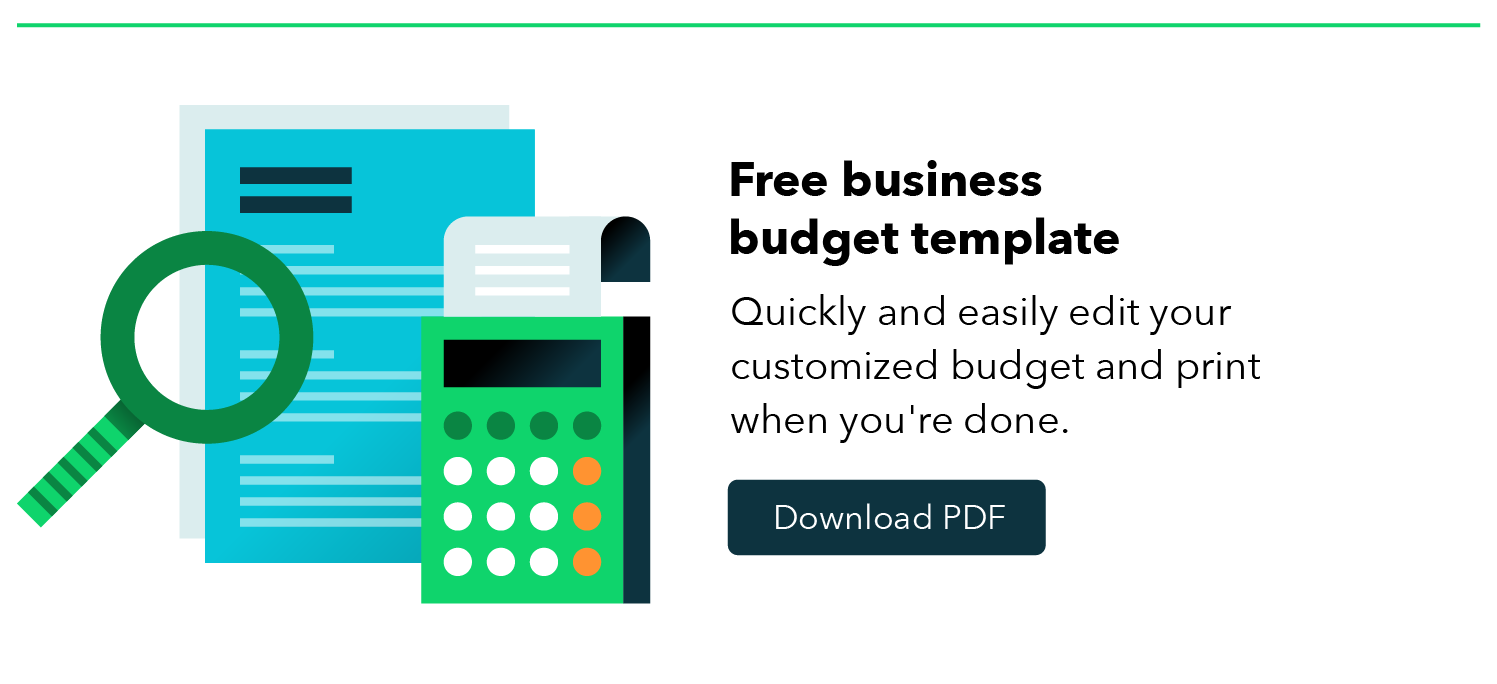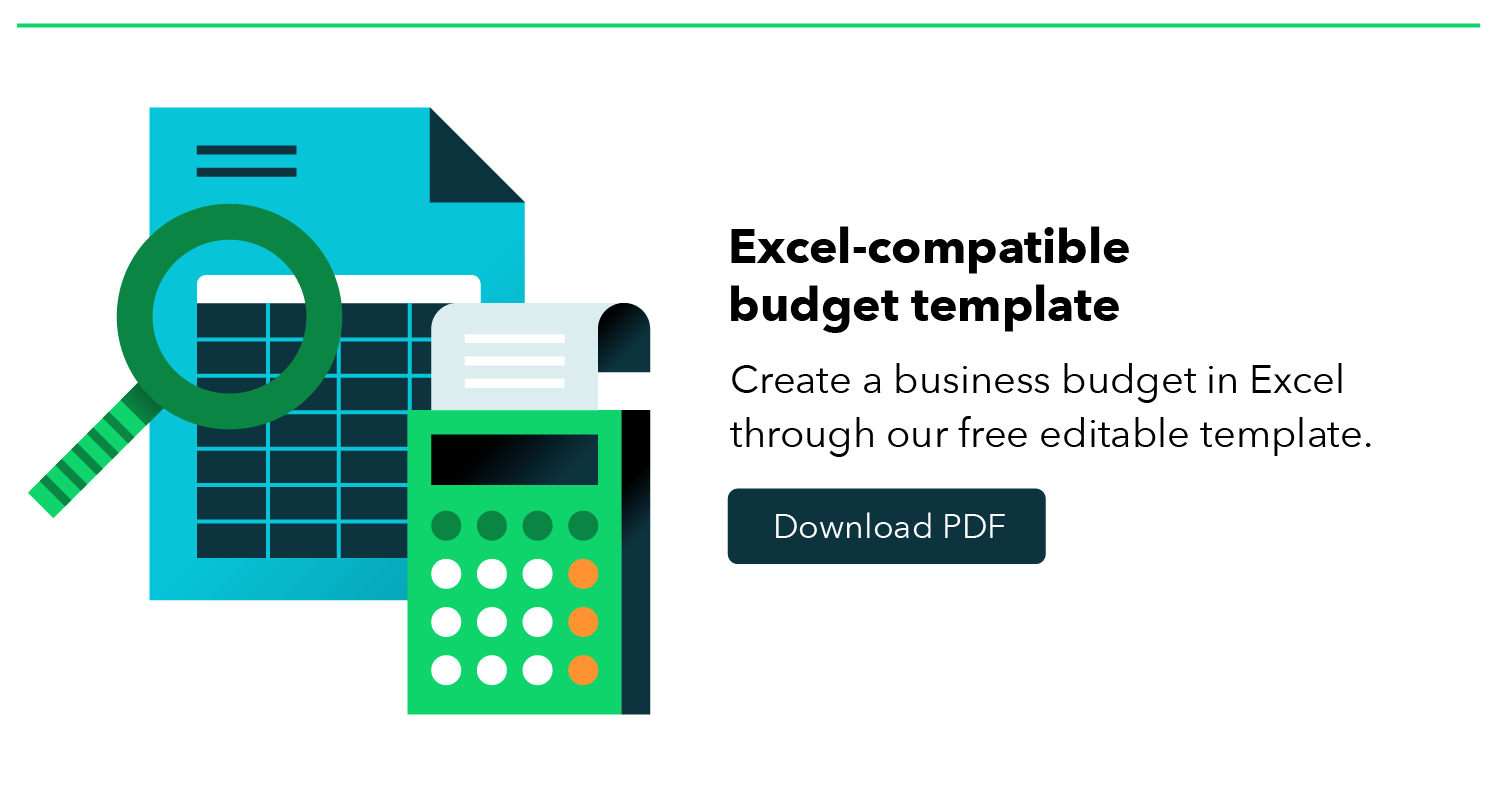
Now you know what a business budget is, why it’s important, and the essential components. Let’s now take a look at the steps you need to take to create one.
Whether you’re optimizing your personal spending or building a business budget, your first step should be aggregating all of your forms of income. Your net income determines how much you can afford to spend. It also indicates your take-home pay and whether your business performance is growing or stagnating.
To find out how much money your business is bringing in, refer to your profit and loss statements. Depending on your business model, you may have several income sources, so be sure to include any and all revenue streams in this section.
Once you’ve added all of your business’s income together, you can subtract your fixed costs. Fixed costs are expenses that remain consistent throughout the year. Whether you pay bills monthly, weekly, or annually, you can expect to spend a set amount of dollars on each expense. These costs are easy to predict, so they’re easy to work into your budget. The one-off expenses, or variable costs? Not so much—more on that in a minute.
Examples of fixed expenses include:
Once you’ve tallied up your fixed expenses, you can subtract that number from the total income you calculated in step 1.
In addition to your fixed costs, you might anticipate monthly operating expenses that may not always be the same amount. These variable expenses may be harder to predict, but you can refer to old receipts and invoices to estimate them.
Examples of variable expenses include:
After identifying your variable expenses and estimating how much they cost each month, subtract the amount from your income.
Life is full of unexpected circumstances. As a business owner, you’re likely familiar with unexpected expenses. New equipment, hiring expenses, and unplanned events can add up, so it’s wise to plan ahead as much as you can.
You can’t predict when you’ll need to pay for an emergency expense or how much it might cost, but you can set aside a cash reserve to lessen the burden.
You’ve accounted for your income and fixed, variable, and emergency expenses. Now you can better understand your business finances by creating a profit and loss (P&L) statement. A P&L statement is a high-level overview that shows whether your organization is profitable or in the red.
When you add up all of your income then subtract your total expenses, you should have a positive or negative number. A positive number indicates that you’re in the black and, therefore, making money. A negative number indicates that you’re in the red and, therefore, burning a hole in your pocket.
Your P&L statement serves as a baseline for creating your business budget. You can access your profit and loss statement, track trends, monitor invoices, and more from your QuickBooks account.
Keep in mind that your profit and loss statement may not always show you the results you want. But with better business budgeting and forward thinking, you can set yourself up for a brighter and more profitable future.
After reviewing your P&L statement, you’ll have a better idea of where you’re spending your money—and if you’re spending responsibly. With this data in mind, you’re ready to draft your business budget for the next year, quarter, or month. Most businesses opt for quarterly budgets.
A basic budget outlines your expenditures and designates limits for each over a given period. This outline can help you determine whether you’re earning and spending within your abilities. With QuickBooks, you can easily glean insight into spending patterns and assess where your business stands financially.

Track and manage your whole financial picture in one place - from bank transactions, expenses and beyond.
Start hereEvery small business has a niche, workflow, and financial goals. So it’s important to remember that there’s no one-size-fits-all approach to business budgeting. As you learn how to build a business budget and experiment with the strategies you’ve learned, consider the following:
A great business budget creates a clear connection between your day-to-day operations and financial resources. It can help you navigate tough business decisions and even help you identify areas for growth. But an effective budget doesn’t happen overnight. As you create and reflect on your business budget, keep these small business budget best practices in mind:
If you’re just getting started with budgeting for your business, these templates are a great medium for learning the process. We invite you to create copies, download, edit, and print these business budget templates.
Use this editable and printable template to create a quick and easy budget for your business:

Use our free Excel template to develop a budget for your business. The template uses an example budget from an imagined business, Widget Inc., to help guide you through the process of creating a business budget

Input the year-end balance sheet and income statement into your Excel template.
Equity is the difference between assets and liabilities—the true value of your business. The $10,000 net income in the income statement increases equity in the year-end balance sheet.
Next, we’ll make some assumptions for the upcoming year. In this example, Widget Inc.’s budget accounts for changes in sales, cost of sales, employee payroll costs, and other expenses.
Some accounting transactions, however, are unusual and cannot be included in a budget. For example, Widget Inc. had a $5,000 loss on the sale of equipment in the prior year.
Widget Inc.’s primary business is manufacturing and selling widgets, and the sale of equipment is not part of its annual budget. Accountants refer to these transactions as non-operating income and losses because day-to-day business operations don’t generate them.
Widget Inc. produces a budget income statement using the assumptions in step 2. Note that the Widget Inc. budget has a line item for gain or loss on sale, other revenue . While the company may have an actual transaction in the category, this line has a zero budget.
The budgeted balance sheet includes assumptions that address each of the line items in the report. The budget provides percentage increases or decreases from the prior year, and 2 categories have no change.
A cash roll-forward report lists your beginning cash balance, expected cash inflow and outflow, and your ending balance in cash for each month of the year.
The balance sheet and the income statement are financial statements , but the cash roll-forward is an informal internal report. The statement of cash flows is generated as part of your financial statements, but a cash roll-forward is more useful for budgeting purposes.
Business owners should create cash roll-forwards last because they need a cash projection for each month. Step 5 presents the cash roll-forward for January. You’ll see that the beginning of January cash balance ($10,000) is the year-end cash balance in the prior year’s balance sheet.
The majority of cash collections are from sales and the bulk of cash payments are for inventory. When a business sells inventory, the dollar amount transfers to the cost of sales, which is the largest expense in the budget. So it makes sense that the biggest cash outflow is for inventory.
Widget Inc. assumes that cash received for sales and the cash paid for inventory will be evenly distributed over 12 months. In reality, the payments will be uneven, but the cash inflows and outflows can be difficult to predict by month.
The budget also includes miscellaneous receivables collected in cash and other cash payments, such as payroll costs.
The beginning cash balance for February ($10,500) is the ending cash balance for January, and this connection applies to each month of the year. The February cash budget uses some of the same assumptions for sales and inventory purchases. The ending cash balance for February is also the March beginning cash balance.
Widget Inc. continues this same cash roll-forward process until the company has a cash budget for each month.
Building a business budget can feel like an overwhelming process, but it’s an essential one if you want to have an edge on the competition, maintain financial stability, and move your business forward.
QuickBooks features tools like business banking that automatically matches to your books , a business debit card integrated with your accounting software, and budget envelopes, making it easy to manage your business finances. Explore our product features to learn more.

Ken Boyd is a co-founder of AccountingEd.com and owns St. Louis Test Preparation (AccountingAccidentally.com). He provides blogs, videos, and speaking services on accounting and finance. Ken is the author of four Dummies books, including "Cost Accounting for Dummies."
1. QuickBooks Money: QuickBooks Money is a standalone Intuit offering that includes QuickBooks Payments and QuickBooks Checking. Intuit accounts are subject to eligibility criteria, credit, and application approval. Banking services provided by and the QuickBooks Visa® Debit Card is issued by Green Dot Bank, Member FDIC, pursuant to license from Visa U.S.A., Inc. Visa is a registered trademark of Visa International Service Association. QuickBooks Checking Deposit Account Agreement applies. Banking services and debit card opening are subject to identity verification and approval by Green Dot Bank. Money movement services are provided by Intuit Payments Inc., licensed as a Money Transmitter by the New York State Department of Financial Services. For more information about Intuit Payments' money transmission licenses, please visit https://www.intuit.com/legal/licenses/payment-licenses/ . No subscription cost or monthly fees. Other fees and limits, including transaction-based fees, apply.
Envelopes: You can create up to 9 Envelopes within your primary QuickBooks Checking account. Money in Envelopes must be moved to the available balance in your primary QuickBooks Checking account before it can be used. Envelopes within your primary QuickBooks Checking account will automatically earn interest once created. At the close of each statement cycle, the interest earned on funds in your Envelopes will be credited to each Envelope in proportion to the average daily balance of each Envelope. See Deposit Account Agreement for terms and conditions. movement services are provided by Intuit Payments Inc., licensed as a Money Transmitter by the New York State Department of Financial Services. For more information about Intuit Payments' money transmission licenses, please visit https://www.intuit.com/legal/licenses/payment-licenses/ .
This content is for information purposes only and should not be considered legal, accounting, or tax advice, or a substitute for obtaining such advice specific to your business. Additional information and exceptions may apply. Applicable laws may vary by state or locality. No assurance is given that the information is comprehensive in its coverage or that it is suitable in dealing with a customer’s particular situation. Intuit Inc. does not have any responsibility for updating or revising any information presented herein. Accordingly, the information provided should not be relied upon as a substitute for independent research. Intuit Inc. does not warrant that the material contained herein will continue to be accurate nor that it is completely free of errors when published. Readers should verify statements before relying on them.
We provide third-party links as a convenience and for informational purposes only. Intuit does not endorse or approve these products and services, or the opinions of these corporations or organizations or individuals. Intuit accepts no responsibility for the accuracy, legality, or content on these sites.